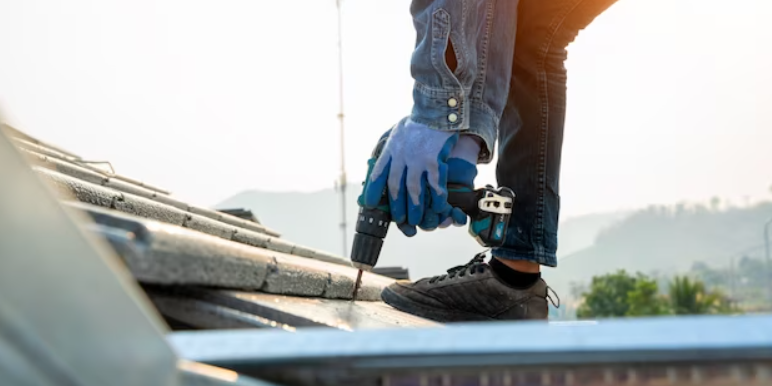The ideal time for roof replacement is when you’re mentally and financially ready. Effective planning ensures a top-notch outcome. With experts like Long Roofing, seasonal weather concerns are alleviated, as they manage the project seamlessly. While each season presents its own challenges or benefits, Long Roofing offers year-round suitability for roof replacement. Discover more about the opportune moments for Roof Replacement Solutions and how to tailor the timeline to your project with Long Roofing.
Addressing Roof Issues: Shingles, Blisters, and Punctures
- Missing Roof Shingles:
Roof shingles are susceptible to displacement from flying debris and high winds, exposing the roof’s underlayment and causing significant damage. The exposure of the underlayment not only compromises the roof’s integrity but also leaves your home vulnerable to leaks and extreme temperatures. The absence of shingles may invite wildlife, like squirrels and raccoons, seeking refuge, leading to additional damage and pest-related issues.
- Roof Blisters:
Roof blisters pose a potential threat, gradually causing severe damage. These blisters form when pockets of air get trapped between roofing layers and expand as temperatures rise. Large roof blisters can escalate, eventually bursting and causing leaks. Immediate repair is crucial to prevent the spread of blisters across the roof, ensuring the longevity of the structure.
- Roof Punctures:
Despite favorable weather, occasional strong storms can result in falling tree branches, flying debris, and other elements leading to roof punctures. Prompt repair is essential when punctures occur to prevent further damage. Timely addressing of such issues ensures the continued resilience of your roof against unexpected weather events.
Recognizing the Telltale Signs for Roof Replacement: A Comprehensive Guide
1. Visible Wear-and-Tear:
External damages like missing, cracked, or broken shingles, along with signs of water pooling on flat roofs, are clear indicators that your roof is showing wear-and-tear. When the roofing material displays such external issues, it’s a definite signal that it’s time to consider roof replacement.
2. Age:
The age of a roof is a critical factor. Depending on the material and climate, a roof with asphalt shingles typically has a lifespan of 15 to 25 years. Curling shingles and buckling roof boards serve as visible cues reflecting the age of the roof, prompting consideration for replacement.
3. Light Filtering Through:
If sunlight is visible through your ceiling during the day, it’s a strong indication of damaged shingles. This clear sign underscores the need for Roof Replacement Solutions to address compromised roofing integrity.
4. Sagging Roof or Bulging Areas:
Structural damage, often caused by moisture seeping between layers over time, manifests as a sagging roof or bulging areas. Internal indicators may include a sagging ceiling, water stains, or leaks. Addressing a sagging roof promptly is crucial for maintaining the structural stability of your home.
5. Improper Installation:
Errors during the initial roof installation can lead to premature replacements or repairs. A well-installed roof should maintain its appearance for many years. The presence of roof cement is a red flag, indicating improper installation. Roof cement, acting like a bandaid, traps moisture and exacerbates damage, necessitating earlier-than-expected repairs or replacements.
Recognizing these five signs is instrumental in determining when it’s time to replace a roof. Proactive attention to these indicators ensures the longevity and structural soundness of your home, preventing more extensive and costly issues down the line. Regular inspections and timely interventions by qualified professionals are crucial for a roof’s health and longevity.
The Roof Replacement Solutions is a substantial project for homeowners, typically prompted by factors such as wear and tear, storm damage, or the natural aging of the current roofing structure. In recent times, there has been a growing emphasis on “cool roofs” as a notable and environmentally friendly solution that enhances energy efficiency.
Understanding Roof Replacement Solutions
Roof Replacement Solutions is a crucial decision for homeowners, requiring careful consideration of various factors. Traditional roofing materials like asphalt shingles, while durable, may not offer the energy efficiency and environmental benefits that modern alternatives can provide. This has led to the rise of innovative solutions, with cool roofs standing out as a compelling option.
Cool roofs are designed to redirect a higher portion of sunlight and absorb less heat when juxtaposed with standard roofs. This is accomplished by applying specialized reflective materials or coatings, which can be incorporated into existing roofing materials or seamlessly integrated into new roofing systems. The main goal is to lower the roof’s temperature, subsequently reducing indoor temperatures and decreasing the reliance on air conditioning.
Benefits of Cool Roofs
- Energy Efficiency: One of the key advantages of cool roofs is their energy efficiency. By reflecting sunlight and reducing heat absorption, cool roofs can significantly decrease the amount of heat transferred into a building. This, in turn, lowers the need for air conditioning, leading to reduced energy consumption and lower utility bills.
- Environmental Impact: Cool roofs contribute to environmental sustainability by mitigating the urban heat island effect. Traditional dark roofs absorb and retain heat, leading to elevated temperatures in urban areas. Cool roofs help combat this phenomenon by reflecting sunlight, minimizing heat absorption, and maintaining cooler ambient temperatures.
- Sustained Financial Benefits: Although the initial installation cost of a cool roof may exceed that of traditional roofing materials, the prolonged savings in energy expenses frequently surpass the upfront investment. Moreover, certain areas provide incentives or rebates for adopting cool roofs, rendering them an economically appealing choice.
Roof Replacement and Insurance Claims
Homeowners often wonder whether their insurance policies cover roof replacement. In many cases, Roof Insurance Claims for replacement are approved when the damage is caused by a covered peril, such as hailstorms, hurricanes, or fallen trees. However, the type of roofing material chosen for replacement may impact the approval process.
Cool roofs, being a relatively newer technology, might require additional documentation and communication with insurance providers. It is crucial for homeowners to consult their insurance policies and engage in open communication with their insurers to ensure that cool roof installations are covered. Some insurance companies may even offer discounts or incentives for installing energy-efficient roofing systems.
Navigating the Installation Process
The decision to upgrade to a cool roof involves several considerations. Homeowners should start by conducting a thorough assessment of their existing roof, considering factors such as its age, condition, and the local climate. Consulting with a professional roofing contractor can provide valuable insights into the feasibility of a cool roof installation.
During the installation process, it is essential to work with reputable contractors experienced in cool roof technologies. Proper installation is critical to realizing the full benefits of a cool roof, including enhanced energy efficiency and longevity. Homeowners should request detailed quotes, inquire about warranties, and verify that the chosen contractor is licensed and insured.
Conclusion
Roof replacement is a significant investment that can bring numerous benefits, especially when considering innovative solutions like cool roofs. These energy-efficient systems not only contribute to environmental sustainability but also offer long-term cost savings. Homeowners contemplating roof replacement should carefully assess the advantages of cool roofs and, if viable, explore the potential impact on Roof Insurance Claims.
As the roofing industry continues to evolve, staying informed about the latest technologies and engaging in open communication with insurance providers will empower homeowners to make informed decisions about their roof replacement projects. With the right approach, upgrading to a cool roof can be a smart investment in both the comfort of the home and the planet.







